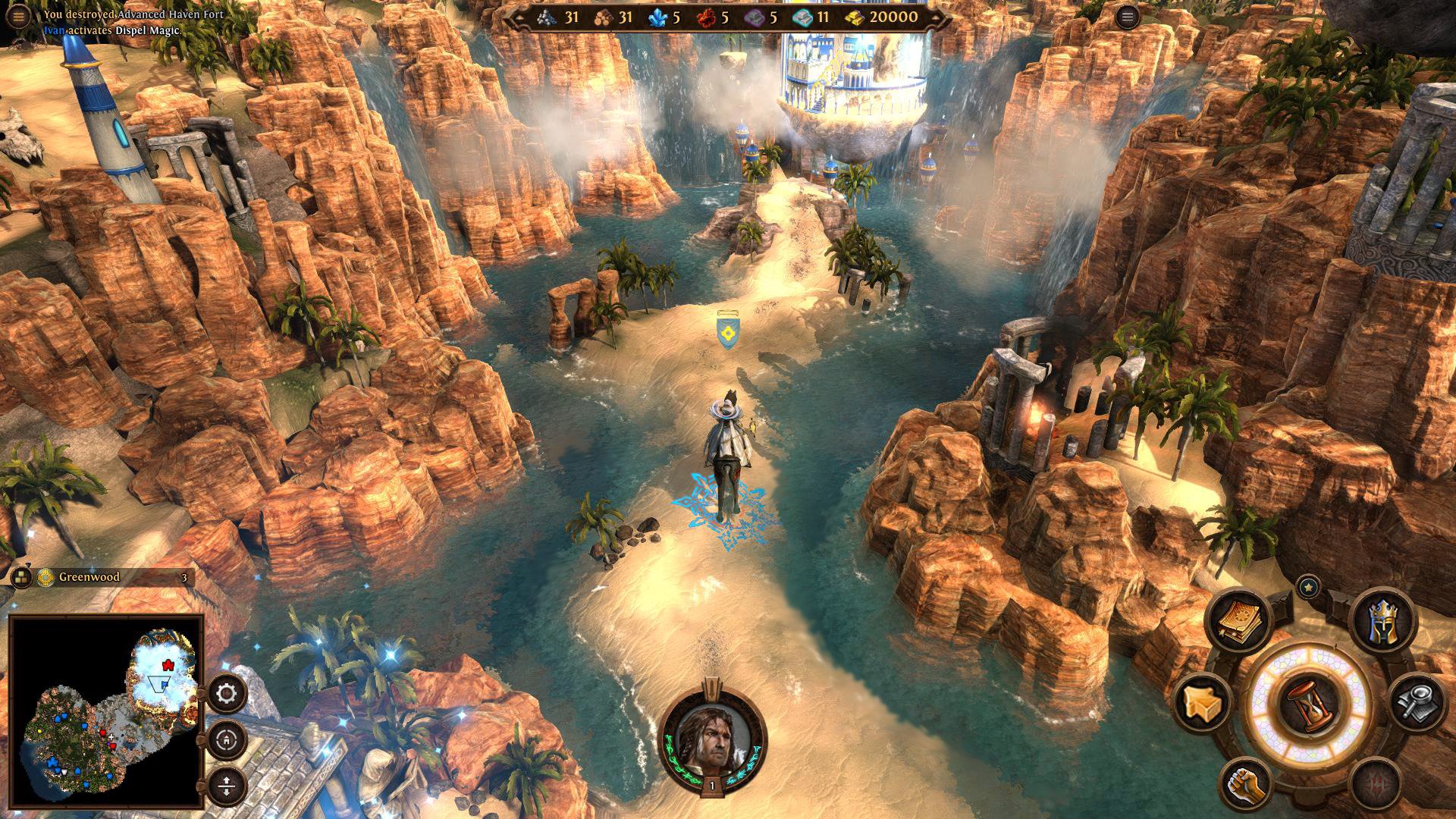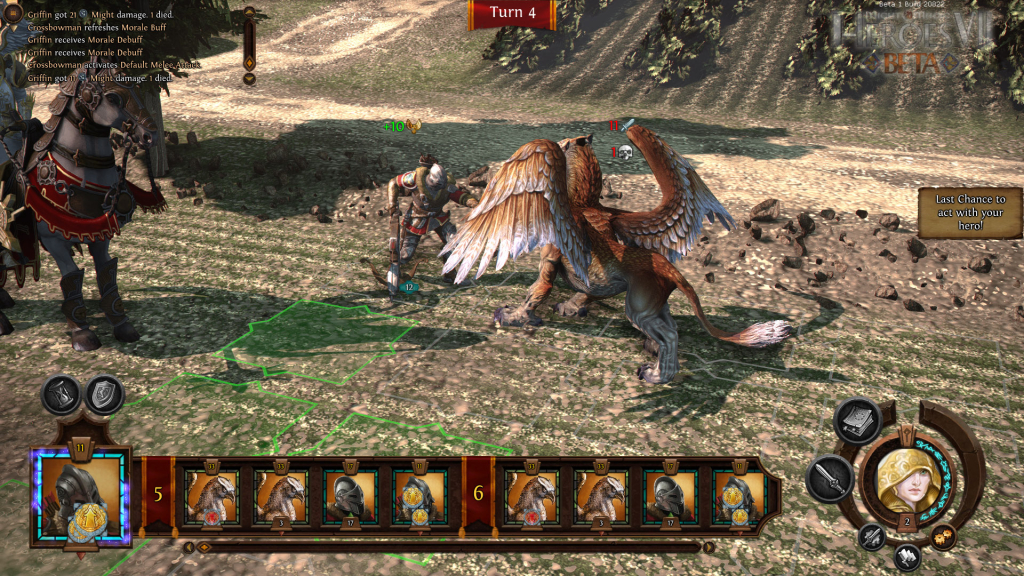Search
[{{{type}}}] {{{reason}}}
{{/data.error.root_cause}}{{{_source.title}}} {{#_source.showPrice}} {{{_source.displayPrice}}} {{/_source.showPrice}}
{{#_source.showLink}} {{/_source.showLink}} {{#_source.showDate}}{{{_source.displayDate}}}
{{/_source.showDate}}{{{_source.description}}}
{{#_source.additionalInfo}}{{#_source.additionalFields}} {{#title}} {{{label}}}: {{{title}}} {{/title}} {{/_source.additionalFields}}
{{/_source.additionalInfo}}- Details
- Category: Computer
- By Jason Gress
- Hits: 6638
Might & Magic Heroes VII (PC)

Might & Magic Heroes VII
Developed By: Limbic Entertainment
Published By: Ubisoft
Release Date: September 29, 2015
Available On: PC
Genre: Turn based strategy
ESRB Rating: T for Blood and Gore, Fantasy Violence, Mild Language
Number of Players: 1-8, local or online
Retail Price: $59.99
(Amazon Affiliate Link)
Version Reviewed: 1.0.1 through 1.2.1
Thank you Ubisoft for sending us this game for review!
The Might and Magic Heroes series (formerly known as Heroes of Might and Magic) is a long running turn based strategy series that I played and loved greatly in the mid to late 1990s, and continues to this day. Those classics were the second and third installments, which many fans consider some of the best games of their kind. Having not played a Heroes game since then, what surprised me is how little has changed.
In each case, there is an overworld map view, where your hero travels along a map finding treasure, creatures to battle (or, with luck, join your army), and mines and such to take control of. You can also attack enemy towns, and take them over to your side if victorious. Each hero can walk a certain number of steps per day, and you can also upgrade any towns you control during that time. You can then recruit creatures, and the total you can recruit increases each week. This process repeats, and eventually, one army overtakes the others, and someone is the victor. This usually requires many battles in order to get there, as well as careful resource management.
During battle, there is a grid on the screen, with your friendly units on one side, and the enemy units on the other. Based on each creature's initiative, they take their turn, in order, one at a time. In earlier games, everything was laid out in a grid of hexagons, but with this later game, they are normal square grids, though you can still flank your opponents for more damage. The heroes can also cast spells or issue orders during battle, which can greatly affect the outcome. Overall, it's a simple system, but enjoyable enough, and with enough depth that the games have stood the test of time.
In Heroes VII, the Duke Ivan calls forth advisers to discuss how to deal with a new threat, as the Empress was recently murdered. Left in her wake are many rivals who wish to conquer the kingdom. Each of the six factions has a story to tell, and you can play as each of them in the interactive retelling of their stories. After completing a minimum of two of them, you can go on to Ivan's final campaign to resolve the issue at hand.

Strong Points: Classic gameplay that has stood the test of time; good graphics; nice music; interesting storylines
Weak Points: Incredibly buggy; some cut scenes have odd talking manikins
Moral Warnings: Violence; some cut scenes have blood and gore; pentagrams and other similar symbols present; death, demons, and necromancy present and playable; minor curse word used; lesbian love relationship between a human and a Djinn
Each of the factions is uniquely skilled and balanced. The Heroes are balanced as well, as they also tend to have certain types of skills available. For example, even with a fully undead party, only necromancer heroes can raise their slain enemies from the dead to serve them as skeletons.
Not only are there necromancers, but also wizards, orcs, knights, elves, and dark elves. These factions are called Necropolis, Academy, Stronghold, Haven, Sylvan, and Dungeon. These are all very similar to (but not exactly the same as) classic factions from previous games. Dwarves, devils, and others are missing; perhaps they will arrive with an expansion pack.
As is probably obvious by now, this is set in a fantasy environment, with all of the classic tropes included, like wizards, knights, elves, and so on. Also included are some of the caveats, like the prevalence of magic in the world. The magic arts is not just fairy tale, or even Tolkien; little difference on a practical level is placed between 'light' magic, and 'dark'. Necromancy, as previously mentioned, is very much a thing here. Pentagrams are used as warding symbols; on unit descriptions, if a creature is resistant to a type of magic, it shows up as a pentagram in that color. There are enemies and allies from all along the spectrum: everything from priests and angels to liches and demons.
Unit types vary in power, range, strength, and resource cost. Some units also have special abilities that set them apart. Core units are typically inexpensive, and able to be recruited in large numbers, but do little damage and have few hit points. However, given a large enough stack, any army can and should fear. It is not uncommon for necromancers in particular, to build stacks of skeletons in the thousands. While individual units are worthless, when in stacks that large, they can defeat almost any enemy in a few hits. A well placed haste or teleport can wreak havok on the enemy.
Elite creatures are usually quite a bit stronger, but also more expensive. Despite this, the tradeoff is often worth it. One creature might have an area of effect attack, while another may avoid all counter-attacks. They also can take quite a bit more damage, making them more resilient as well.
Each faction also has champion creatures, which are the most powerful available for them. Each has two, of which a town may only have one of them. While extremely expensive and in low quantity, they can often turn the tide of battle by themselves with their over the top abilities and crazy damage. Even small stacks of these can make a big impact.

Higher is better
(10/10 is perfect)
Game Score - 74%
Gameplay - 15/20
Graphics - 8/10
Sound - 10/10
Stability - 1/5
Controls - 3/5
Morality Score - 53%
Violence - 6/10
Language - 8/10
Sexual Content - 2.5/10
Occult/Supernatural - 2/10
Cultural/Moral/Ethical - 8/10
If it's not already obvious, I really enjoyed this series in the past, and I looked forward to playing it again. In some ways, it delivered. The graphics are vastly improved over the last entry I played oh so many years ago, and the music, sound effects, etc. also delivered. The stories were also interesting, and the scale is massive in some cases. What surprised me is how buggy this game is.
I played through several patch cycles, and while it improved each time, the fact is that I experienced a few crashes, some near outright hangs, and some atrocious load times, as well as graphical and other odd glitches throughout. It also has much higher system requirements than expected given the graphical fidelity, which I did not notice on my desktop, but my gaming laptop (i7, GeForce GTX 660M) struggled quite a bit until I lowered my settings a lot. It also helps to have a larger screen, as I had to squint with my smaller laptop screen in some areas. (I could just be getting old.) Despite this, I was able to get though the campaigns I played without issue, but perhaps I got lucky, if forum posts are to be believed. It's a good thing they implemented autosaves, even if recovering from a crash can take close to a minute with those load times. The last patch did improve that a lot, though.
Not only were there bugs, but also a lack of polish. The first really bad impression was quite simply the game's introductory sequence. After some nice CGI, we see character portraits that talk with some voice acting, but do not move their mouth or bodies in any way. Basically voiceover manikins. It's kind of spooky, in an 'uncanny valley' kind of way. (The 'uncanny valley' is a phenomenon where something human-like but not quite is disturbing to the viewer. More information <here> https://en.wikipedia.org/wiki/Uncanny_valley) I was honestly surprised at that choice; I couldn't tell if it was supposed to be an artistic one, or just lazy. But it elicited a negative reaction out of me, and I suspect I am not alone.
Another point of lacking polish is a complete lack of user training. For a 'vet' like me, I was able to pick things up fairly quickly, but I was surprised to find almost no instruction at all on how to play the game. The included manual is buried in the game's files, which I would never have noticed had I not explored them to listen to the OST. (The OST is included in the deluxe edition, which appears to be what this review code was.) It's also pretty basic, as only some of the user interface is explained. I never figured out how to become governor, for example, until I read about someone else figuring out the same issue.
Despite these things, the core of the gameplay is solid, as it was twenty years ago. And there is definitely plenty to do, as there are a whole lot of maps and campaigns to go around. There is also local and online multiplayer, and a map editor for even more potential scenarios to conquer. It definitely has that 'one more turn' aspect that it has always had.
As previously mentioned, there is significant occult symbolism and ideas in this game. If you can look past that, there is also an issue where a certain woman hero is portrayed as being deeply in love with another female, in this case a djinn. There is no room for doubt that the relationship is lesbian in nature, though there is nothing visually explicit. Other people in the game world look down on her for her 'bedroom proclivities'. I feel like it was written in such a way as to try to bring sympathy from the player to her situation.
Other areas are relatively tame, with a few exceptions. Most violence is RPG violence, where the order is issued and something like a sword is swung, with little blood on the battlefield itself. There is a cutscene that is pretty graphic, with a decapitated head. While there is some unique language (using words like 'teat', for example), the only word that qualifies as a curse word is 'b*stard'. While some female enemies wear what is basically the equivalent to a bikini, they actual cover more than some games like this, where they might cover even less.
Might & Magic Heroes VII has been a bit of a love/hate relationship for me. I've loved the gameplay, except for when it crashed. I've loved the graphics, except for when there are graphical bugs. I've loved the storyline and lore, except when they assault my sense of morality. I love some of the art, except for, well, unnecessary (but game consistent, to be honest, as older entries also feature it) occult symbolism I would not prefer. And honestly, that's how I feel about this game. Each good thing about it is balanced with something not so good. The game, if completely patched, has the potential to be a pretty memorable game in the series. As for the rest? I leave that to you.






